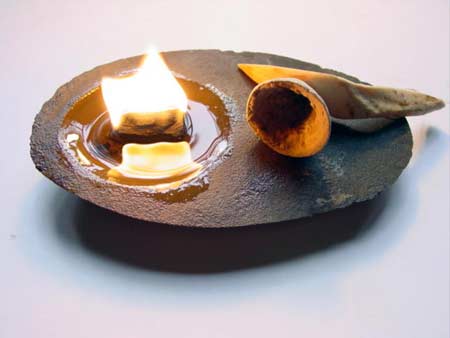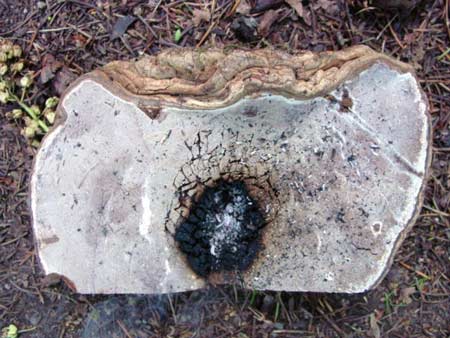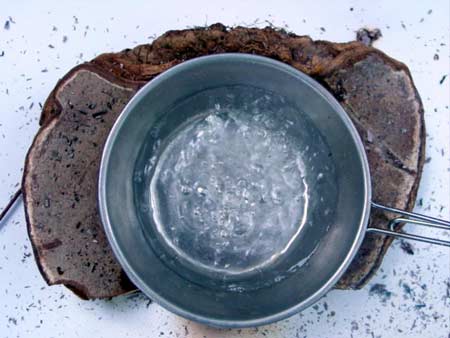 |
The Usefulness of Polypore Fungi
in Primitive
Fire Making
Page 2
|
| Now it was time to add the coal, or fire-egg, to a nest of fuel from which it
could hatch into fire. Earlier in the day Jeff had kneaded some dry sagebrush
bark into a bowl-shaped mass. He then filled the depression in the middle of
this bark nest with shredded bits of red-belted conk (Fomitopsis pinicola).
On top of this a pinch of flowering cattail fluff was added to ensure a gentle
gradation of fuel sizes so that the coal could grow hot enough to produce flame.
Stone oil/fat lamp with fungal (Red-Belted Conk) wick: |
 |
| |
|
|
| |
Using a thin stick to separate the coal from the confines of the hearthboard,
while cradling the coal on the thin piece of bark, Jeff transfers the ember to
the nest. Blowing gently on this tinder bundle, the coal engulfs the fuels and
produces flame in just a few seconds. A spark was planted inside me at that very
moment.
Bow drill fire-making tinder is but one primitive use of polypores. Recently
I’ve focused my efforts on a variety of fire-making ways, from flint and steel
(spark-based) to fire plow (lateral friction--as Tom Hanks demonstrated in the
movie Castaway) to bow drill and hand drill (rotational friction), among others.
Having experimented with a few thousand combinations of woods available here and
the central coast section of California (my former residence), I find myself
yearning to include lesser-tried natural materials--which brings me to the pyro-properties
of polypores. The most common sizeable conks around here are red-belted conk (Fomitopsis
pinicola), hemlock varnished conk (Ganoderma tsugae), and artist’s
conk (Ganoderma applanatum), of which all are currently (August)
blossoming in a burgeoning bouquet of baby buttons on stumps and downed logs.
Also, i was sent some birch polypore (Piptoporus betulina) and tinder
fungus (Fomes fomentarius) from Ohio to experiment with.I have already explained the bow drill process, which can be seen in the
accompanying photos. Aside from being used as tinder, certain polypores can also
be used as hearthboards (see photos). Compared to other esoteric hearthboard
materials (rock, shell, antler, bone) that I have used, shelf fungi work better
by far. These polypores have generated coals in conjunction with a wooden
spindle: artist’s conk, red-belted conk, birch polypore and tinder fungus.
Casual observation indicates that these fungal hearthboards produce hotter,
longer-lived embers than those derived solely from wood.
Starting the "Bush Stove" (Artist's Conk): |
 |
| |
|
In general, the amount of effort required to produce fire by utilizing shelf
fungi as hearthboards and tinder is less than that expended using wood. I
suspect this is the case because shelf fungi can dry out more quickly than wood,
since the pore layer (from which the mushroom’s spores fall from) provides a
conduit for the quick evaporation of moisture. One might also consider the diet
that certain members of this mushroom family enjoys. As shelf fungi infect the
trunk of a tree, it either digests cellulose (the substance that plant cell
walls are made out of), leaving a brown rot, or cellulose and lignin (the glue
that holds plant cell walls together), creating a white rot. I’ve had more
success doing bow drill and hand drill on species that digest cellulose and
lignin to produce a white rot (e.g. red-belted conk). Cellulose is comprised of
glucose molecules linked primarily by glycosidic bonds. When metabolized, it
decomposes into fatty acids, which are said to be volatile.
The hand drill (see photo) is structurally similar to the bow drill, but the bow
and hand-hold are replaced by your strength. Bearing down on a longer, thinner
spindle requires more stamina and power in order to achieve a coal in this
manner. However, the intrinsic mystical simplicity of “rubbing two sticks
together” and creating fire, without the technological evolution of the bow,
strongly endears me to this method of friction fire. To date, I’ve only used the
artist’s conk as a hearthboard successfully with hand drill. How amazing it
would be to drill an ember on a shelf fungus while it remained attached to the
host tree!
Boiling water on the Bush Stove: |
 |
| |
| Before the match was invented in 1826, flint and steel was the prevalent method
used to start a fire. Taking a piece of flint, quartz, pendantlite, marcasite,
or other hard iron pyrite, one can strike a piece of these minerals against a
high-carbon steel (e.g. a file or older knife blade). The mineral tears off
small particles of the metal, causing these pieces to heat up and hopefully land
on dry tinder (mind your aim!). Traditionally, a char cloth was used to catch
the hot sparks. Char cloth can be made by burning a piece of cotton fabric while
it lay inside a reasonably air-tight container. The cloth blackens as it burns
incompletely and readily catches fire when introduced to an intense heat source.
There may be ways to primitively craft an easily combustible, charred material,
but one can turn to the gastronomic workings of the fungus gnat larvae for an
effortless flint and steel tinder alternative. Probably anyone who has left
dried conks in a bag for months can attest to the ravages that hidden insects
can inflict on a poor, defenseless polypore and the subsequent powdery debris
that settles to the bottom of the bag. Recently I collected some dried sulfur
shelf (Laetiporus sulphureus) fungi that had enjoyed protection from the
elements by growing on the underside of a large, slightly elevated log. I was
demonstrating flint and steel to school groups at the time and thought these
specimens could prove useful. After storing the sulfur shelf in a basket for a
while I noticed small piles of whitish powder accumulating on the floor. Upon
inspection I discovered small holes running through the fungi (and many more
fungus gnats flying around my place than usual). Thinking that this powder might
burn, I cranked out a few hand drill embers and placed them on top of the
powder. The embers steadily engulfed the new fuel, extending the lives of the
coals (hence the oft-used term in primitive circles, coal extender).
Considering this success, I wondered if the sulfur shelf, in its whole, intact,
unprocessed condition, would catch a spark and grow a coal. Well, not only did
the sulfur shelf catch sparks easily and burn quickly, but blowing on the
polypore and even smothering it would not put it out—I found this out by
discovering the extinguished (not!) fungi fully engulfed in flame on my front
steps 20 minutes after I supposedly put it out! Only dousing it in water would
lay the fire to rest. Tinder fungus and birch polypore also work well in this
manner. It was very satisfying to have a nine-year-old girl from inner-city
Seattle successfully make fire with flint, steel and sulfur shelf later that
week.
Storm with Red-Belted Conk and Hemlock Varnished
Conk: |
 |
| |
|
Polypores also generate a by-product that is useful to these efforts. White
and brown wood rots can be ground up and applied to a friction-fire generated
coal in order to extend its life, giving a person more time to construct a
tinder nest in which the coal will hopefully be blown into flames. Wood infected
with brown rot burns slow and doesn’t create flame by itself. Preliminary trials
that I have conducted show that brown rot is more effective than white rot as a
coal extender. When an ember is placed on a chunk of white rot, the wood bursts
into flame. Perhaps some of you can enlighten me as to why this might be the
case—I’m not up on the specific roles that cellulose and lignin play in the
combustion of wood. This has important foraging implications in primitive or
survival situations. We get 92 inches of rain per year here, and up to 160
inches just 50 miles to the west. Imagine yourself in such a wet environment, in
need of a fire. You are searching for dry fuel—all wooden surfaces in the forest
are useless. But dig into a log, especially a rotten log (which is infinitely
easier to dig into), and pull out some fluffy, dry, punky, white
wood...congratulations, you’re warm!
Even the pore layers of shelf fungi have a luminescent use. If you look closely
at the photo of the stone oil lamp, you can see the brown lump of a wick that
sits in the fuel (be it rendered deer fat, asphaltum or olive oil). This wick is
a piece of red-belted conk, whose pore layer siphons the liquid fuel into the
flame that dances atop the fungal mass.
Lastly, we come to the conk stove. Simply place a burning coal on top of any
large conk and watch the fungus slowly become engulfed in flame. Better yet,
procure a piece of hollow elderberry or bamboo stem and blow gently on the
burning mass, and watch the fungus quickly become engulfed in flame. Then set a
pot of water directly on the conk and voila, it boils within ten minutes.
I hope this article has warmed you to the possibilities of extending your love
for primitive skills toward Kingdom Fungi and discovering their role in our
pre-historic relationship with our environment.
|
| |
|
Back to
Page 1 |
| |
| Viwe this article as a PDF |
| |
|
|
|
 |
 |
 |



